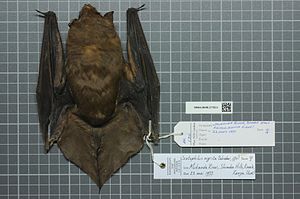Giant house bat
| Giant house bat | ||||||||||||
|---|---|---|---|---|---|---|---|---|---|---|---|---|

Prepared specimen in a museum collection |
||||||||||||
| Systematics | ||||||||||||
|
||||||||||||
| Scientific name | ||||||||||||
| Scotophilus nigrita | ||||||||||||
| ( Schreber , 1774) |
The giant house bat ( Scotophilus nigrita ) is a mammal in the smooth-nosed family .
features
With a total length of 18.7 to 19.5 cm, a forearm length of 7.8 to 8.8 cm and a weight of about 89 g, the species is significantly larger and heavier than other representatives of the genus Scotophilus . The tail is 6.4 to 9.2 cm long and the wingspan is 57.5 to 60 cm. The giant house bat has no nasal blade and 20 to 24 mm long ears that are not connected. The tail is predominantly or completely embedded in the tail fly skin (uropatagium). This bat has four molars on each side of the upper jaw and five molars in the lower jaw halves. The species has two upper and no lower incisors.
The fur of the various specimens is colored black-brown, sepia- brown, olive-brown, red-brown or gray-brown on the upper side , while the underside is covered with yellow-gray, light yellow or white fur. The ears and the flight skin are black-brown.
distribution
The giant house bat lives in Africa south of the Sahara to South Africa . The documented sites are, however, widely scattered. Furthermore, a large number of different habitats could be determined, from dry savannas and partially deciduous forests to moist savannas and rainforests . In dry areas, the species usually lives in the vicinity of water holes.
Way of life
The individuals usually rest individually under house roofs or in hollowed-out trees. Sometimes temperatures of over 40 ° C prevail in the hiding place. Based on the shape of the teeth and based on knowledge of closely related species, it is assumed that the giant house bat feeds on insects and small vertebrates .
status
The species is listed as Least Concern by the IUCN due to its large distribution area .
Individual evidence
- ^ Wilson & Reeder (eds.): Mammal Species of the World . 3. Edition. Johns Hopkins University Press, Baltimore 2005, ISBN 0-8018-8221-4 (English, Scotophilus nigrita ).
- ↑ a b c d Jonathan Kingdon (Ed.): Mammals of Africa . 6 volumes. A & C Black, 2013, ISBN 978-1-4081-2254-9 , pp. 678-679 (English, Giant House Bat ).
- ↑ a b Scotophilus nigrita in the endangered Red List species the IUCN 2008. Posted by: Cotterill, FPD, 2008. Accessed on November 3 2,016th
Web links
- Nigel Fernsby (2004) New Bat Species identified in South Africa , report on a specimen temporarily held in captivity with photos, Bat Interest Group of KwaZulu-Natal